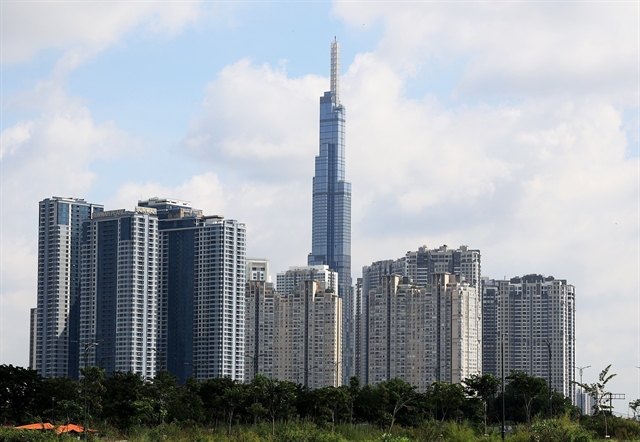 Economy
Economy

 |
| Apartment buildings in HCM City. After a period of stagnation, HCM City’s real estate market is experiencing a robust recovery. VNA/VNS Photo |
Việt Nam’s real estate market is entering a promising new growth cycle, with four major cities – Hà Nội, HCM City, Hải Phòng, and Đà Nẵng – emerging as the key drivers of this momentum.
Data released by Batdongsan.com.vn at their online event on October 7 highlights the remarkable price increases seen from 2021 to 2025.
Hà Nội led with a 112 per cent price rise, followed by Hải Phòng (+71 per cent), Đà Nẵng (+53 per cent), and HCM City (+42 per cent). These four cities have become critical growth poles where infrastructure, industry, trade, tourism, and residential demand intersect.
According to Hà Nghiêm, director of Batdongsan.com.vn’s Đà Nẵng branch, while Hà Nội and HCM City dominate as financial and urban centres, Hải Phòng and Đà Nẵng are thriving thanks to their industrial, logistics, seaport, and tourism development models. This dynamic has expanded development opportunities, especially in suburban areas.
Central region momentum
The Đà Nẵng - Quảng Nam cluster has experienced a significant breakthrough in the third quarter of 2025, driven by three main pillars: trade and tourism, industry and logistics, and the cross-border economy. (Since July 1, 2025 Quảng Nam has merged with Đà Nẵng).
Đà Nẵng has blossomed into a vibrant financial, trade, and tourism hub, while Liên Chiểu and Chu Lai have developed rapidly in industry and logistics. Nam Giang serves as a strategic border gate, together forming a new growth triangle in the Central region.
Interest in real estate surged by 24 per cent in Đà Nẵng and 58 per cent in former Quảng Nam compared to the previous year. Selling prices followed suit, rising 30 per cent in Đà Nẵng and 32 per cent in Quảng Nam.
Notably, cash flow from other localities -- especially Hà Nội (up 141 per cent) and HCM City (up 32 per cent) -- has dominated, surpassing local investment.
Land and apartments stand out as the leading segments in Đà Nẵng. Since early 2023, land prices have increased by 68 per cent, apartments by 50 per cent, with Ngũ Hành Sơn and Sơn Trà districts seeing the most substantial gains at 33 per cent and 41 per cent, respectively.
Đà Nẵng apartments have become one of the country’s top tourist city investments, with a remarkable 146 per cent return over the past two years.
In former Quảng Nam, land accounts for 83 per cent of interest, concentrated mainly in Điện Bàn (+36 per cent) and Núi Thành (+22 per cent), both benefiting from industrial and border economic zone investments.
Nghiêm said that Đà Nẵng’s merger with Quảng Nam provided the city with modern infrastructure and a vast land fund, opening significant development opportunities. Although land prices in 2025 had surged, they remained only about 15 per cent above the 2019 peak, leaving room for future growth.
Northern market strength
In the North, Hải Phòng continues to solidify its position as a leading industrial, commercial and logistics hub, supported by a strong economic foundation and an expansion merger strategy. Following the merger of Hải Dương Province with Hải Phòng in July 2025, the enlarged province of Hải Phòng became the nation’s third-largest economy, boasting a GRDP of VNĐ658 trillion and attracting substantial domestic and foreign investment.
In Q3 2025, Hải Phòng’s real estate market showed promising signs: apartment prices rose 17 per cent from early 2023, rental yields hit 4.6 per cent, and private houses surged 32 per cent, especially in Lê Chân and Kiến An.
Although land interest remains cautious, prices grew 38 per cent, indicating solid central-area demand. Increased search activity from Hà Nội reflects growing inter-regional attraction.
Nguyễn Thị Ngọc Thương, director of Batdongsan.com.vn’s Hải Phòng branch, noted that the city’s merger had created a “super coastal urban area”, integrating production, logistics, trade, and urban development under one administration -- a new national-scale growth pole offering diverse real estate opportunities.
Meanwhile, Hà Nội remains a leading market with steady price growth. In 2025, asking prices rose by 13 per cent, moderating from 2024’s 39 per cent surge yet remaining positive.
Apartments remain a key focus, with prices up 95 per cent since early 2023, especially in high-demand areas like Tây Hồ and Ba Đình, where prices range between VNĐ130-210 million per square metre.
However, affordability remains a challenge, with 56 per cent of respondents considering apartments difficult to access. In contrast, mid-range and popular segments priced below VNĐ55 million per sq.m rose by 57-71 per cent and offered strong rental yields.
Suburban districts such as Đông Anh, Gia Lâm and Long Biên become attractive investment hotspots thanks to favourable infrastructure and available land.
Private houses in Hà Nội gained traction, rising 63 per cent since early 2023, reflecting a preference for long-term ownership. Land prices rose 50 per cent, particularly near the city centre (+95 per cent) and suburban areas (+75 per cent), though market interest remains cautious amid macroeconomic fluctuations.
Southern market rebound
After a period of stagnation, HCM City’s real estate market is experiencing a robust recovery. Supply and liquidity have improved, fueled by renewed investment capital and demand, signalling a potential new growth phase from 2025 to 2030.
Data from Q3 2025 shows average selling prices reaching VNĐ99 million per sq.m -- the highest in two years -- along with a spike in market interest.
Apartment prices in the old city area rose by 35 per cent compared to early 2023, hitting VNĐ72 million sq.m, while Bình Dương increased 30 per cent to VNĐ41 million sq.m. (The provinces of Bình Dương and Bà Rịa Vũng Tàu were incorporated into HCM City in July 2025).
Interest rose by 19 per cent in HCM City and 48 per cent in Bình Dương, highlighting the return of both investment and end-user demand. In contrast, Bà Rịa Vũng Tàu remains sluggish, illustrating regional disparities.
Luxury apartments in District 1 remain top-tier, with prices averaging VNĐ222 million per sq.m, up 39 per cent over two years. Thủ Đức City has emerged as a new hotspot, with prices increasing 32-48 per cent since early 2023, especially in Districts 2, 9, and the centre of Thủ Đức. Its modern infrastructure and status as a "city within a city" continue to attract medium- and long-term investors.
Satellite towns like Bình Dương and Bà Rịa Vũng Tàu show positive momentum. Vũng Tàu apartment prices grew by 12 per cent to VNĐ45 million per sq.m, with Thuận An and Dĩ An rising by 6-8 per cent.
Thủ Dầu Một achieved the highest regional rental yield at 5.1 per cent, double that of central HCM City, reflecting a capital shift to more affordable and profitable outer-city areas.
Suburban apartment supply remains the main market driver. Thuận An and Dĩ An have over 13,000 units priced between VNĐ40-60 million per sq.m, while Thủ Đức offers around 11,800 apartments priced at VNĐ80-120 million per sq.m. Many projects are located along Belt Lines 3 and 4 and the metro, supporting ongoing population decentralisation.
Đinh Minh Tuấn, Southern Regional director of Batdongsan.com.vn, said that the land segment was also recovering, with average land prices rising 6 per cent in old HCM City (to VNĐ69 million per sq.m) and 5 per cent in Bình Dương (to VNĐ21 million per sq.m). VNS